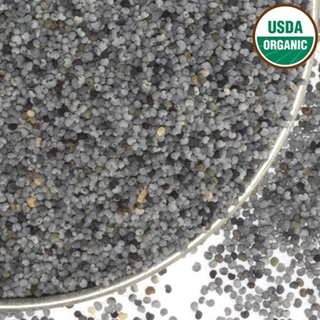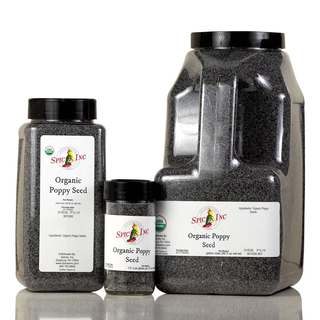Organic Poppy Seed




Organic Poppy Seed
Organic Poppy Seeds, Papaver somniferum, can also be called organic poppy seeds, papaver somniferum seeds unwashed, papaver somniferum seeds bulk or poppy seeds organic. These seeds are small and blue-grey, and are food-grade quality, not pharmaceutical grade.
Organic poppy seeds have an essential oil content of 40%-60% so they contribute a rich mouthfeel to foods.
Businesses who frequently purchase Organic Poppy Seeds are American restaurants; bar and grills; and independent spice shops.
We also have conventional Poppy Seeds available.
Flavor Profile
Poppy seeds are nutty and slightly sweet with a smoky aroma.
How To Use
Organic Poppy Seeds are a great way to garnish food if you want to add a little extra crunchy texture. Sprinkle them over Skillet Olive Bread or press them into fresh Soft Pretzels. Poppy seeds can be ground down to form a paste that is excellent in sweets and on breads, like cookies or babka. Or, blend into the batter when making Carrot Cake Squares. Try stirring into Garbanzo Bean Salad, or strewing them across Roasted Ajvar over Grilled Polenta or Porcini and Potato Soup for visual appeal as well as flavor.
Organic Poppy Seeds work well with other seeds like sesame or pumpkin, and nuts like walnut, hazelnut, and almond. Put in tuna or macaroni salad, cheese dips or logs, soups, coleslaw, or over vegetables and potatoes. Pair with lemon, lavender, chile peppers, ginger, orange, garlic, onion, cabbage, rice, or apples.
| Also Called | Organic poppy seeds, papaver somniferum seeds unwashed, papaver somniferum seeds bulk or poppy seeds organic |
| Species | Papaver somniferum |
| Ingredients | Organic whole poppy seed |
| Flavor Profile | Nutty and slightly sweet with a smoky aroma |
| Oil content | 40-60% |
| Recommended Uses | Breads, crackers, soups, muffins, pretzels, garnish, dressings |
| Cuisine | Global |
| How To Store | Airtight container in a cool, dark place |
| Shelf Life | 1-2 Years |
| Country of Origin | The Netherlands, Australia, Turkey |
Nutrition Facts
Serving Size1 tsp
Amount Per Serving
Calories17
% Daily Value*
Total Fat1g2%
Saturated Fat0g1%
Trans Fat0g
Polyunsaturated Fat1g
Monounsaturated Fat0g
Cholesterol0mg0%
Sodium0.8mg0%
Total Carbohydrate0.9g0%
Dietary Fiber0.6g3%
Total Sugars0.1g
Added Sugars0g0%
Sugar Alcohol0.0g
Protein0.6g1%
Vitamin D0mcg0%
Calcium45mg3%
Iron0mg2%
Potassium23mg0%
*The % Daily Value (DV) tells you how much a nutrient in a serving of food contributes to a daily diet. 2,000 calories a day is used for general nutrition advice. These values were calculated and therefore are approximate. For more accuracy, testing is advised.
